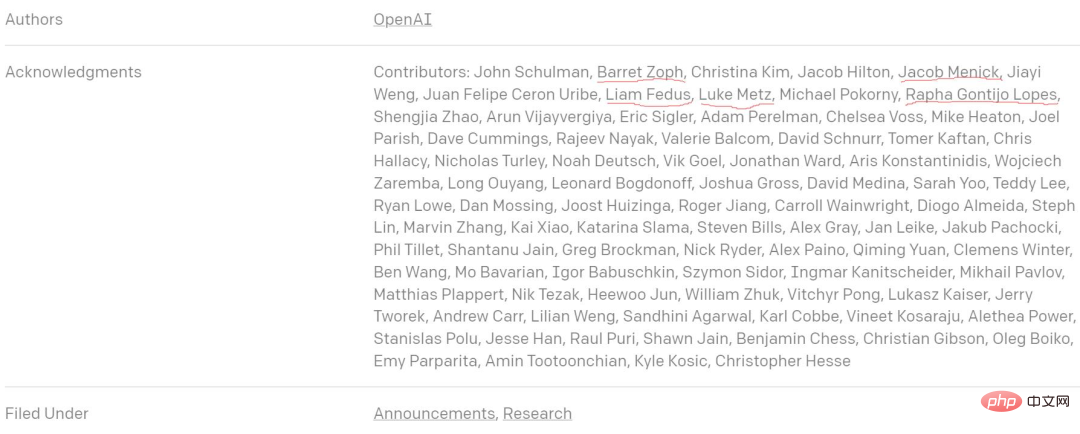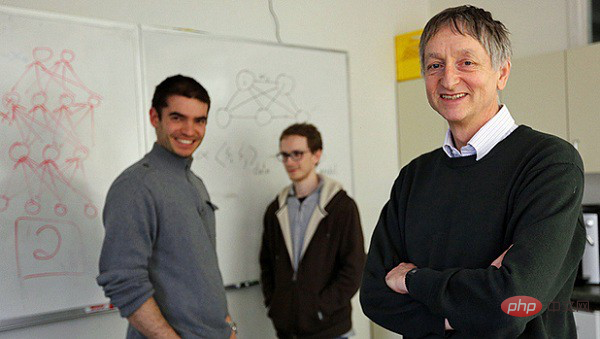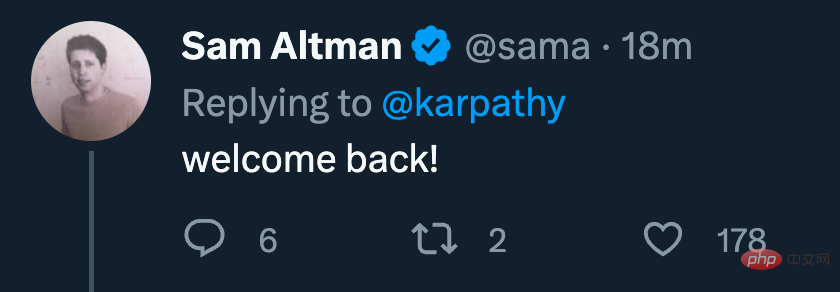Let's go and do ChatGPT! Google AI scholars are jumping to OpenAI
Recently, Google and Microsoft are competing fiercely on ChatGPT search.
Two tech giants have announced plans to integrate large language models (LLMs) into Bing and Google Search respectively. Last week, Bing opened the new technology to some users, while Google also announced that its AI search is open to "trusted testers" ahead of a wider rollout.
Temporarily released to rush for the first time, and products went online even if there were errors. Other Internet companies followed suit, setting off another arms race in the technology field.
While companies are competing for strength, they are also competing for talents. According to reports, OpenAI has been poaching Google's AI scientists, and its recent actions have become more and more "blatant."
Only today, several scientists announced the good news of joining OpenAI on social networks:


The goal is very clear: we are here to build ChatGPT.
##However, this is not a phenomenon that only occurred after the success of ChatGPT. According to a report by The Information, OpenAI, which created the general-purpose intelligent chat robot ChatGPT and the image generator DALL-E, has hired more than a dozen former Google employees in recent months.
A person familiar with the matter told the media that the recently popular ChatGPT has received help from at least five former Google researchers.
In OpenAI’s blog post announcing the launch of ChatGPT on November 30 last year, we saw some noteworthy contributors – Barret Zoph, Liam Fedus, Luke Metz, Jacob Menick and Rapha Gontijo Lopes:

##The current title of these people is either Google AI, or they have started from Google AI jumped to OpenAI.
OpenAI’s chatbot has proven to be very popular with users, accumulating more than 1 million users in the first week and reaching hundreds of millions in early February this year. After the launch of ChatGPT, Microsoft invested billions of dollars in additional investments to gain exclusive access to the new technology and soon released a new version of Bing Search.
Two former employees of Google Brain, Google’s AI unit, told The Information that some employees believe the company culture has become lethargic. Staffers reportedly cited Google's layers of red tape and overly conservative approach to new product initiatives, leading some workers to look for jobs elsewhere.
OpenAI, which is in the spotlight, looks like a good place to be.

In fact, upon closer inspection, jumping from Google to OpenAI is nothing new. OpenAI’s chief scientist Ilya Sutskever came from Google Brain. In 2012, he co-proposed the famous AlexNet with Alex Krizhevsky and Geoffrey Hinton, which promoted the progress of deep learning.

## Ilya Sutskever, Alex Krizhevsky and Geoffrey Hinton.
In the Google Brain team, Sutskever participated in the development of TensorFlow, Google's open source framework for large-scale machine learning. The proposed Seq2seq brought a revolution to machine translation. , also keeps in touch with DeepMind researchers, and is one of the authors of the paper on the cover of Nature featuring AlphaGo.In July 2015, Sutskeve attended a dinner hosted by Y Combinator President Sam Altman at a restaurant on Sand Hill Road, where he met Elon Musk and Greg Brockman. It is said that at that time, everyone present agreed on one thing: an organization dedicated to developing general artificial intelligence had to be a non-profit organization, without any competitive incentives to dilute its mission, and it also needed the best artificial intelligence researchers in the world. He became the co-founder of OpenAI and is now the man behind ChatGPT: Sutskeve once said: “It seems that one day, probably within our lifetimes, we will build an AI system that has the same cognitive capabilities as humans in every meaningful dimension. ” Not long ago, Andrej Karpathy, Tesla’s former senior director of AI, also announced on Twitter that he would return to OpenAI. You know, Karpathy is a founding member and research scientist of OpenAI. But more than a year after OpenAI was founded, Karpathy accepted Musk’s invitation to join Tesla. Now back again. I will be joining OpenAI (again). Like many people in and outside the AI field, I am inspired by the impact of this company's work and have personally benefited from it. Its future potential is particularly exciting; it's a great pleasure to get back into it and help build it! 


Sam Altman said: Welcome back!
#Although OpenAI does not make money, the persistence of building groundbreaking general artificial intelligence and doing the most challenging things has paid off.
also finally led Google to sound the “Code Red” alert.
The above is the detailed content of Let's go and do ChatGPT! Google AI scholars are jumping to OpenAI. For more information, please follow other related articles on the PHP Chinese website!

Hot AI Tools

Undresser.AI Undress
AI-powered app for creating realistic nude photos

AI Clothes Remover
Online AI tool for removing clothes from photos.

Undress AI Tool
Undress images for free

Clothoff.io
AI clothes remover

Video Face Swap
Swap faces in any video effortlessly with our completely free AI face swap tool!

Hot Article

Hot Tools

Notepad++7.3.1
Easy-to-use and free code editor

SublimeText3 Chinese version
Chinese version, very easy to use

Zend Studio 13.0.1
Powerful PHP integrated development environment

Dreamweaver CS6
Visual web development tools

SublimeText3 Mac version
God-level code editing software (SublimeText3)

Hot Topics
 1386
1386
 52
52
 How to solve the complexity of WordPress installation and update using Composer
Apr 17, 2025 pm 10:54 PM
How to solve the complexity of WordPress installation and update using Composer
Apr 17, 2025 pm 10:54 PM
When managing WordPress websites, you often encounter complex operations such as installation, update, and multi-site conversion. These operations are not only time-consuming, but also prone to errors, causing the website to be paralyzed. Combining the WP-CLI core command with Composer can greatly simplify these tasks, improve efficiency and reliability. This article will introduce how to use Composer to solve these problems and improve the convenience of WordPress management.
 How to solve SQL parsing problem? Use greenlion/php-sql-parser!
Apr 17, 2025 pm 09:15 PM
How to solve SQL parsing problem? Use greenlion/php-sql-parser!
Apr 17, 2025 pm 09:15 PM
When developing a project that requires parsing SQL statements, I encountered a tricky problem: how to efficiently parse MySQL's SQL statements and extract the key information. After trying many methods, I found that the greenlion/php-sql-parser library can perfectly solve my needs.
 How to solve complex BelongsToThrough relationship problem in Laravel? Use Composer!
Apr 17, 2025 pm 09:54 PM
How to solve complex BelongsToThrough relationship problem in Laravel? Use Composer!
Apr 17, 2025 pm 09:54 PM
In Laravel development, dealing with complex model relationships has always been a challenge, especially when it comes to multi-level BelongsToThrough relationships. Recently, I encountered this problem in a project dealing with a multi-level model relationship, where traditional HasManyThrough relationships fail to meet the needs, resulting in data queries becoming complex and inefficient. After some exploration, I found the library staudenmeir/belongs-to-through, which easily installed and solved my troubles through Composer.
 How to solve the problem of PHP project code coverage reporting? Using php-coveralls is OK!
Apr 17, 2025 pm 08:03 PM
How to solve the problem of PHP project code coverage reporting? Using php-coveralls is OK!
Apr 17, 2025 pm 08:03 PM
When developing PHP projects, ensuring code coverage is an important part of ensuring code quality. However, when I was using TravisCI for continuous integration, I encountered a problem: the test coverage report was not uploaded to the Coveralls platform, resulting in the inability to monitor and improve code coverage. After some exploration, I found the tool php-coveralls, which not only solved my problem, but also greatly simplified the configuration process.
 How to solve the complex problem of PHP geodata processing? Use Composer and GeoPHP!
Apr 17, 2025 pm 08:30 PM
How to solve the complex problem of PHP geodata processing? Use Composer and GeoPHP!
Apr 17, 2025 pm 08:30 PM
When developing a Geographic Information System (GIS), I encountered a difficult problem: how to efficiently handle various geographic data formats such as WKT, WKB, GeoJSON, etc. in PHP. I've tried multiple methods, but none of them can effectively solve the conversion and operational issues between these formats. Finally, I found the GeoPHP library, which easily integrates through Composer, and it completely solved my troubles.
 Solve CSS prefix problem using Composer: Practice of padaliyajay/php-autoprefixer library
Apr 17, 2025 pm 11:27 PM
Solve CSS prefix problem using Composer: Practice of padaliyajay/php-autoprefixer library
Apr 17, 2025 pm 11:27 PM
I'm having a tricky problem when developing a front-end project: I need to manually add a browser prefix to the CSS properties to ensure compatibility. This is not only time consuming, but also error-prone. After some exploration, I discovered the padaliyajay/php-autoprefixer library, which easily solved my troubles with Composer.
 How to solve the problem of virtual columns in Laravel model? Use stancl/virtualcolumn!
Apr 17, 2025 pm 09:48 PM
How to solve the problem of virtual columns in Laravel model? Use stancl/virtualcolumn!
Apr 17, 2025 pm 09:48 PM
During Laravel development, it is often necessary to add virtual columns to the model to handle complex data logic. However, adding virtual columns directly into the model can lead to complexity of database migration and maintenance. After I encountered this problem in my project, I successfully solved this problem by using the stancl/virtualcolumn library. This library not only simplifies the management of virtual columns, but also improves the maintainability and efficiency of the code.
 git software installation tutorial
Apr 17, 2025 pm 12:06 PM
git software installation tutorial
Apr 17, 2025 pm 12:06 PM
Git Software Installation Guide: Visit the official Git website to download the installer for Windows, MacOS, or Linux. Run the installer and follow the prompts. Configure Git: Set username, email, and select a text editor. For Windows users, configure the Git Bash environment.




